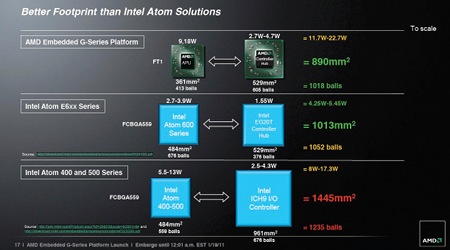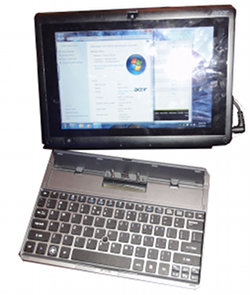AMD puts Fusion on diet so it can squeeze into tablets
Jan 31, 2011 — by LinuxDevices Staff — from the LinuxDevices Archive — 1 viewsAMD is reportedly on the verge of releasing a tablet-specific implementation of its C-50 Fusion APU (“accelerated processing unit”). By relying on a simplified I/O controller, the device — set for a debut in a new Acer tablet — will offer accelerated HD graphics and consume just five Watts, according to the PC Watch website.
AMD calls its "Fusion" processors APUs because they combine x86-compatible "Bobcat" CPUs with on-chip GPUs (graphics processing units). While recent Intel offerings (such as the Sandy Bridge Cores) do the same thing, AMD's are touted as offering better graphics: Intel's chips can only manage DirectX 10, whereas the Fusion offerings do "full" DirectX 1; they also have dedicated hardware for HD video (H.264, VC-1, and MPEG2 decoding), according to AMD.
| Model | CPU Cores |
CPU Clock Speed | Number of GPU Cores | GPU clock Speed | TDP |
| AMD E-350 | 2 | 1.6GHz | 80 | 500MHz | 18W |
| AMD E-240 | 1 | 1.5GHz | 80 | 500MHz | 18W |
| AMD C-50 | 2 | 1.0GHz | 80 | 280MHz | 9W |
| AMD C-30 | 1 | 1.2GHz | 80 | 280MHz | 9 |
Mobile versions of the new "Fusion" processors finally were announced at the Consumer Electronics Show (CES) earlier this month: the 1.6GHz E-350, 1.5GHz E-240, 1.0GHz C-50, and 1.2GHz C-30. Some of these chips (listed above) have already been adopted in portable computers: Acer's Aspire One 522, HP's Pavilion DM1, Lenovo's ThinkPad X120e, MSI's U270, and Toshiba's Satellite C655D.
| Model | Clock speed | Cores | Graphics | TDP max |
| T56N | 1.6GHz | 2 | HD6310 | 18W |
| T48N | 1.4GHz | 2 | HD6310 | 18W |
| T40N | 1.0GHz | 2 | HD6250 | 9W |
| T52R | 1.5GHz | 1 | HD6310 | 18W |
| T44R | 1.2GHz | 1 | HD6250 | 9W |
AMD's embedded G-series processors
Subsequently, AMD announced five G-Series Fusion parts (above) — with clock speeds ranging from 1.0GHz to 1.6GHz — that took AMD's fight against the Atom into embedded territory. According to AMD's analysis (below), its two-chip platform is about 13 percent smaller than Intel's Atom E6xx platform, and 60 percent smaller than the Atom 4xx/5xx ("Pineview") platforms.

AMD's Fusion chipsets offer smaller footprints than those for Intel's Atom
Source: AMD
(Click to enlarge)
Lowering power consumption to rival Intel
It's clear from the above that AMD's Fusion chipset, at 19 x 19mm for the APU and 23 x 23mm for the controller hub, is not only more compact than Atom solutions, but also more graphically adept. But, as we've commented in the past, with TDPs of 9 Watts or 18 Watts, Fusion remains something of a power glutton compared to Intel's Oak Trail. These figures make it uncompetitive in the burgeoning tablet market.
In order to fix this problem, AMD plans to pair its dual-core, 1.0GHz C-50 with a simplified I/O controller, achieving a TDP of just 5 Watts, according to PC Watch reporter Kasahara Kazuteru. Unlike the A50M used by the E-Series and C-Series, or the A55E used by the G-Series, the tablet-specific controller will save power by delivering only a single USB port and a lower RAM limit, AMD CTO Joe Macri is said to have explained.

An Acer tablet equipped with AMD's 1.0GHz C-50 and new I/O controller
PC Watch claims the first tablet to use the C-50 along with the new controller will be from Acer. The unnamed device (above) will be sold with a detachable keyboard accessory and will be available "in the coming months," according to the story.
Meanwhile, Netbook News has published benchmarks of Toshiba's NB500D, a version of the previously released, Intel-equipped NB520 that now becomes one of the first netbooks to employ the C-50. According to the website, the device has CPU performance that's a little bit slower than an equivalent with Intel's dual-core Atom N550, but also has slightly improved consumption and much faster graphics.
This article was originally published on LinuxDevices.com and has been donated to the open source community by QuinStreet Inc. Please visit LinuxToday.com for up-to-date news and articles about Linux and open source.